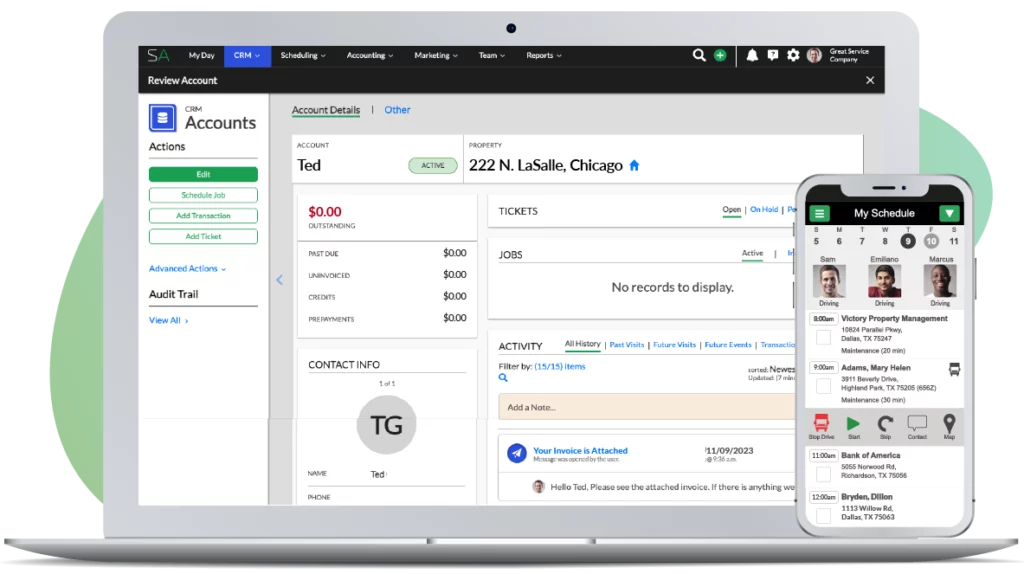This questions is from Jacob, and the question is, “How much money should I be making per hour as a business?” I can’t tell you exactly, but I can give you some information that will probably help you. Let me first give an example in commercial. Commercial maintenance, first you’ve got to understand there’s a lot of factors that go into this. That’s why there is no real easy rule of thumb. You could talk to one guy that’s predominantly commercial and you’re going to hear a lower hourly number; whereas, if you talk to a guy that’s residential you’re going to hear a higher number.
If you talk to a guy that’s doing lawn mowing, you’re going to a number; whereas, if you talk to a guy that’s doing irrigation, you’re going to hear a higher hourly number. It’s all over the board. That’s why I say there is no way I can possibly directly answer, but I can give you some clues.
Let’s start with commercial. In commercial you might hear a guy say, “Yeah, we have to achieve a $25 per man hour number.” You might hear somebody else say, “I need to achieve a $30 man hour number, or $35 man hour number. That’s kind of a range, $25 to $35 is a range I’ve heard in the commercial space, and the reason you’re going to hear … But you’ve got to analyze it more than that. A guy could be in commercial and he could say, “Our goal, we need to achieve $28 per man hour to be competitive in this market and at this moment in time.”
Things have changed over the years. You could have a guy that got out of the business in 2002. He could say, “Back when I was in the business in 2002, we were hitting $34 a man hour. Well, now it’s 2013 and everything is different. He may not be able to sell work at that same man hour rate if he was still in the business. Now he might have to sell at $27. Things have changed. Things have tightened up and people are very competitive. You have to be very careful that you’re talking to someone that’s talking in today’s prices.
Second, if you talk to somebody that’s in the commercial space and they predominantly serve smaller commercial properties where they’re going from property to property more like serving large residential. That’s a totally different game than a guy that’s serving big commercial where he sends a truck to a job for the entire day, or he has a crew that services a property for 3 days, or he has 5 crews that go to a property for 2 days. Totally different businesses and they’re both called commercial and, they’re, therefore, are going to have completely different hourly rates.
If I can send a crew to a job site in the morning, and they come home at night. Then tomorrow, I send them to the same job site and they come home at night, or if I could send them to a job site in a truck and all their equipment is stored on site and they just drive back to their homes they don’t even have to come back to my office, I can build a lot lower rate than if I have to send them to one property, send them to the next, to the next, to the next, to the next because you have what’s called unproductive, unbillable time built in to your pricing in that second scenario.
In my first scenario, we’re billing straight time. I send them out to the property. We’re billing time all day long except for their break. I don’t have the unproductive time of as much load and unload time. I don’t have as much travel and drive time. I don’t have maybe a time built in to send them on parts runs and material runs. It’s a totally different game so I can look at the numbers different.
Now let’s say that you have a commercial … First, understand that I don’t have a whole bunch of cost so I could maybe sell work at $30 an hour, whereas, if I have a lot of drive time and unproductive time, I might have to sell work at $40 a man hour when we’re actually performing the work because I’ve got to factor in the drive time and all that unproductive time. Now I’m quoting 2 different rates when you’re talking to my comp-, me versus another company where we serve both commercial, but we have different types of commercial.
You’ve also got to know if this hourly rate includes drive time or not. Again, in the commercial space I might say we need to achieve $27 a man hour. For $27 a man hour, that means the moment we finish one job get in the truck and drive to the next one and complete that job, that’s all time on the clock. That drive time is built in to the job time that follows, and, therefore, all of that time together, drive and production, for all of that time I need to be averaging $27 a man hour.
Then if you talk to a different commercial company doing the same type of work, they might say, “We need to achieve $32 a man hour. When they say $32 a man hour, what they’re thinking is once we set foot on the job site from that moment in time until we complete that job, I need to achieve $32 a man hour. They don’t give you … They don’t have a number for that drive time in between. That is a cost, but they’re not tracking that time and saying, “While we’re driving, we need to be achieving $32 a man hour.” The $32 a man hour is only for the time on the job site. They are not pricing in … They are pricing in, in a sense, but they’re not counting drive time in their hourly wage that they quote as a company, better said, hourly rate that they’re trying to achieve. Hopefully that makes sense.
Whenever you’re asking questions in your market because by market pricing an hourly rate is different as well. It’s totally different in Texas than it is in New York. It’s totally different in Alabama than it is in Connecticut. It’s totally different in California than it is in Florida; different markets, different rates, different employee costs, different everything. When you’re researching this in your local market and you’re asking these questions, the questions to know to ask are, “Does your rate include drive time? Does your rate include … Are you doing big commercial? You doing smaller commercial?”
When you move into residential, it’s sort of the same thing. If I can send a client … If I can do 3 large residential properties in a day, I don’t move my truck as much. I don’t have some of the costs of the guy doing 35 little bitty jobs per day and so my hourly rate might be bigger. If I’m doing pest control in their one-off visits, my rate has to be higher than it might be for mowing 7 yards in a row because: 1. My pest control tech has a higher level of training, a higher level of licensing. We’re using chemical. He also is having to do more driving to get to each of these one-off jobs that are called in and booked by appointment, and so that rate’s higher.
A lot of times when you’re asking a company, “What’s your hourly rate?” They might give you a blended rate across service offerings, but the real questions is, “What’s your hourly rate for mowing? What’s your hourly rate for irrigation? What’s your hourly rate for pest control?” Those are the clues. Those are the questions and that’s what you’ve got to ask. I’ve heard $25 to in the $30s for in the commercial and I’ve totally seen for maintenance and for maintenance and lawn care, I’ve seen guys in the high $20s to well into the $40s, and $50s, and some in the $60s for residential.
I would add one more thing. You will sometimes hear about a guy in residential or commercial and their averages are a really high number and I’m making this up, but I’m doing $50 a man hour. Then you’ll talk to another company and they’re doing $42 a man hour. These are made up numbers, but it communicates a point. Or you find a guy does … Let me exaggerate that a little more. You’ve got a guy that’s doing $40 a man hour in residential and then you compare him to another guy that’s doing $60 a man hour in residential. Now I can tell you, for example, in Toronto, Canada, they bill at a lot higher rate than we do here in Texas. That’s because a completely different area.
That’s one difference, but the other difference is, you might have a guy billing out at $60 and when you dig in the guy that’s billing out at $60 is running about a quarter million dollar a year business. He’s been doing it for quite a while and he’s slowly acquired those clients; whereas, the guy that’s running a $9 million or $10 million company, he has to sell a lot more work and he has a lot more attrition he’s dealing with where he has to get more and more and more clients. It’s harder to sell work so he can’t sell $10 million of work at $60 an hour.
There isn’t enough people to buy at $60 a man hour, but when you’re running a smaller company and you’re getting the business over time and you’re a little … You’re more able to cherry pick because you only have to sell so much work, you could sell more work at a higher price, but when you want to scale to $10 million, you’re not going to be able to sell at the same prices and scale that fast. Hopefully, I’ve communicated that clearly in that you can if you’re very strategic and say, “I want to run a smaller company and I’m going to cherry pick the work and I’m going to sell it at a high price into very specific neighborhoods, or very specific types of clients, and I realize there’s only so many of them, so I can only grow this business so big, but that’s okay. I’m going to achieve this high dollar per hour rate.”
If that’s your plan, that’s doable, but you’ve got to be, of course, in the right market. But if your plan is you want to build a $10 million residential company, in most markets good luck selling at very high prices. I’m not saying you can’t sell at higher prices that are very profitable. I’m just saying you can’t sell at the extremes of the market and find enough people to build a $10 million per year business because they just aren’t out there. You can’t sell at the very, very top of the market and get that much, that big of a percentage of the market.
Again, these are all questions as you’re thinking about this to ask yourself and ask others so that when somebody says, “Yeah, we sell at $25 a man hour,” you don’t go out and copy the $25 a man hour. You got to really dig in. I hope that helps you as you’re analyzing this and researching it in your local market. Good luck.



